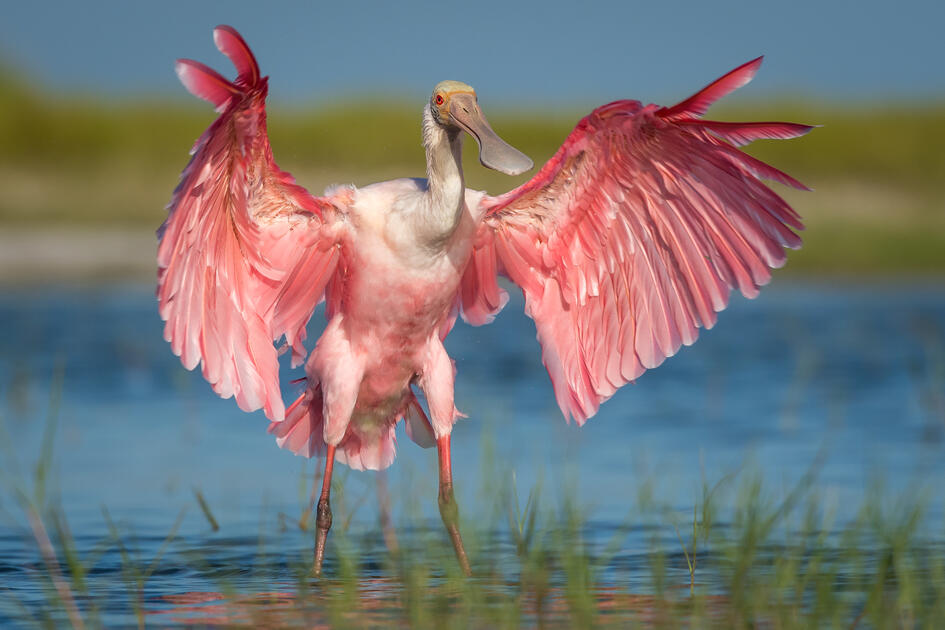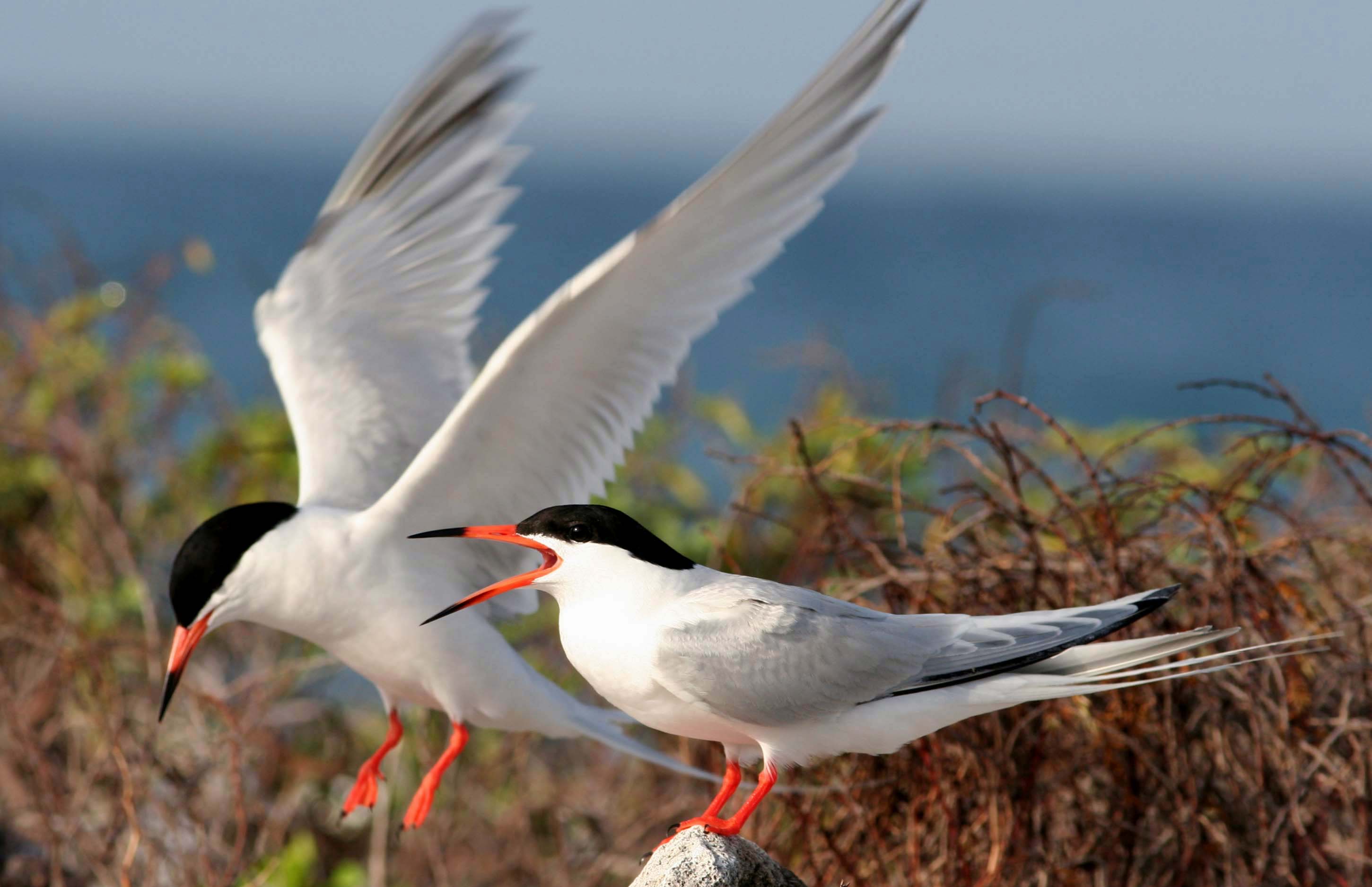When you hear the term pink birds in Florida, perhaps the first thought that pops into your head is a flamingo. But did you know that there are a bunch of other bird species that have some degree of pink coloration? In this article, we’ll be going over 7 pink birds that are often seen in Florida.
1. American Flamingo
Scientific Name: Phoenicopterus ruber
Range: Florida, Cuba, Puerto Rico, Central America, Northern South America
One of the most well-known pink birds, the American flamingo is a relatively local shorebird with a very long red ‘coat-hanger’ shaped neck, long legs, and covered in bright pink plumage.
Juveniles are brown and white overall during their first year, eventually obtaining the pink coat in roughly 2-3 years. Some may confuse the species with the Roseate Spoonbill, which, while also being a pink shorebird, significantly differs from the American flamingo in body shape.
American flamingos can be found in flocks by the shallow waters of salt or brackish water bodies, as well as in alkaline lakes.
The American flamingo’s diet consists mainly of algae, small seeds, and aquatic invertebrates, such as brine, fly larvae, shrimp, and mollusks. As shorebirds/wading birds, American flamingos feed while wading in the shallow water, stirring up mud on the bottom using their feet.
2. Roseate Spoonbill

Scientific Name: Platalea ajaja
Range: Southern and Eastern United States, Central America, South America
The roseate spoonbill is a pink-wading bird with a long and flat beak that resembles a spoon, hence its name. Adults are primarily pink, with red wing patches, an orange tail, and a bare light-green head. Juveniles are more light-colored than adults but the pink plumage is still visible.
Unlike the flamingo, the roseate spoonbill’s range is much larger, and its uniquely shaped beak, shorter legs, and shorter neck set it apart as well.
The typical habitats for the roseate spoonbill include the freshwater and saltwater wetlands from the Gulf Coast down through South America. Mangrove islands and some dredge-spoil islands are common nesting areas for this bird.
The roseate spoonbill feeds mainly on crayfish, shrimp, crabs, other small crustaceans, aquatic insects, frogs, newts, and some small fish. Similar to the flamingo, the roseate spoonbill feeds while sifting side-by-side through the shallow water.
3. Scarlet Ibis
Scientific Name: Eudocimus ruber
Range: Northern South America, Breeds in Florida, and western Europe
The scarlet ibis is a bright orange-red ibis with black wingtips, long legs, and a very long and narrow beak. Breeding adults have black beaks that may appear pink at times, while juveniles have dark plumage above with white undersides and pink beaks.
The scarlet ibis is not native to the United States, but imported birds were reared with the native white ibis, thus creating pink hybrids that can be seen in Florida.
The typical native habitats for the scarlet ibis include aquatic areas, such as mangroves, swamps, tidal mudflats, wetlands, shallow lakes, and adjacent muddy estuaries.
The scarlet ibis’s diet is quite varied, with a combination usually including crabs, other small crustaceans, small fish, mollusks, amphibians, worms, and small insects (especially scarabs and ground beetles). They utilize their long beaks to forage in shallow waters, poking mud and soft sand to pick out their prey.
4. Purple Finch

Scientific Name: Haemorhous purpureus
Range: North America
The purple finch is a small finch with males covered in a raspberry red plumage on the head and breast with a light pink tone elsewhere, and females and juveniles having a contrasting head pattern with pale eyebrows, darker cheeks, and bold streaking on the sides.
Similar to the house finch, but the males lack the obvious streaks on the sides while being more colorful, especially on the wings and back.
The purple finch breeds in coniferous and mixed forests, while they winter in a larger variety of habitats, most of which contain trees, such as shrublands, old fields, forest edges, and backyards.
The typical diet of the purple finch includes seeds, buds, berries, and insects. They mainly feed on seeds in the winter, such as those from ash and elm trees, as well as weed and grass seeds. Insects, such as caterpillars and beetles, are fed mainly in the summer. Juveniles are fed mainly seeds.
5. House Finch
Scientific Name: Haemorhous mexicanus
Range: Southern Canada, United States, Mexico
The house finch is a common finch that, for males, consists of different shades of red and pink, along with the occasional yellow or orange. The red color is mainly limited to the head and upper chest, which sharply contrasts with the gray-brown nape, back, and wings. Females are a dull gray-brown overall with plain faces and minor streaks on the underparts.
The house finch can be found in many suburban settings, such as near buildings, lawns, small conifers, and urban centers across North America. They may also be found in more rural areas, such as barns, stables, open woods, brushy field edges, and deserts. They are frequent visitors of bird feeders.
The house finch’s diet mainly consists of seeds, buds, and berries. They feed almost entirely on plant material. The seeds mainly come from weeds, while they feed more on buds and flower parts in the spring and berries and fruits in the late summer or fall.
6. Roseate Tern

Scientific Name: Sterna dougallii
Range: Eastern United States, Cuba, Puerto Rico, Western Europe, Madagascar, Northern Australia, Southeast Asia
The roseate tern is a pale-colored tern with a faint rose-pink wash on the belly, a very long forked tail, and a beak whose color varies widely among the regions.
Old-world birds are known to arrive at breeding grounds with a black beak that eventually turns to red, while new-world birds arrive with an already red beak that turns a darker red. The bird resembles the Common Tern, but has significantly whiter wings.
Though the roseate tern is found throughout the world, they typically only breed in local colonies on offshore islands. They may also be found in flocks with other terns near beaches, mudflats, or estuaries.
As carnivores, roseate terns consume almost entirely small marine fish, such as herring and sand lance. They’ll also occasionally supplement their diet with crustaceans, insects, or squid.
7. Rose-Breasted Grosbeak
Scientific Name: Pheucticus ludovicianus
Range: North and Central America, Northern South America
The rose-breasted grosbeak is a large grosbeak with breeding adult males having black and white plumage throughout with a bright red triangle on the breast. Nonbreeding males, females, and juveniles have streaks below, along with a brilliant head pattern.
All have a thick, pale pink beak. Females are occasionally confused with the Purple Finch and Black-Headed Grosbeak, but the former is usually larger, has a unique pink beak, has whiter markings on the wings, and lacks any orange tones.
The rose-breasted grosbeak’s habitat typically includes deciduous woods, orchards, and groves during most of the year. They breed mainly in open deciduous woods, along with mixed woods, where they often favor edges or openings containing shrubs and tall trees. During migration, they may be found in any wooded or semi-open area all the way down to northern South America. They are known to visit feeders.
The rose-breasted grosbeak feeds mainly on insects, seeds, and berries. Roughly half of their annual diet consists of insects, such as beetles, caterpillars, grasshoppers, and true bugs, among others, along with some snails and spiders. Seeds, such as those from elm trees, buds, and flowers, make up the rest of their diet.
Conclusion
Even though pink plumage isn’t exactly the most common trait you’ll find on a bird, there are still a relatively large variety of these birds that share this trait in just Florida alone. And it’s because of the uniqueness of this trait that you should have no trouble spotting at least one of the birds we’ve included on this list once you know where to look.
Related articles:
17 Birds that Migrate to Florida (With Photos)
20 Brown Birds in Florida (with photos)





